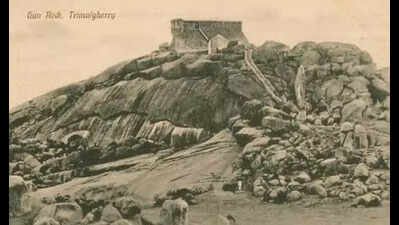- News
- City News
- Hyderabad News
- WORLD HERITAGE DAY: Hyderabad’s Monuments: Testament Of Timeless Resilience
Trending
WORLD HERITAGE DAY: Hyderabad’s Monuments: Testament Of Timeless Resilience
Hyderabad: Keeping with this year's theme — heritage under threat from disasters and conflicts — TOI explores Hyderabad's historic military sites that not only survived colonial-era battles but have been carefully preserved too.
Military Reformatory, Trimulgherry: Hyderabad's Forgotten Cellular Jail
A few metres from the Trimulgherry junction in Secunderabad Cantt lies one of Hyderabad's most significant colonial relics—the Military Reformatory. "It was built in 1858 by the British Army after the First War of Independence in 1857. This cellular prison was a high-security facility," said Mohammad Safiullah from Deccan Heritage Trust sharing how this fortress is eerily reminiscent of the Kalapani jail in the Andaman Islands and reportedly witnessed execution of about 500 people, mostly freedom fighters. It has 75 prison cells, a central watchtower, hanging rooms, and Gothic-arched verandahs. "The reformatory is managed by the 125th Battalion of the Territorial Army," added Safiullah stressing the need to preserve such structures that witnessed critical chapters of the fight for independence. "It should also be made accessible for public," he said. In 1997, Intach honoured it with the Charminar Heritage Award.
Military Hospital, Trimulgherry: Legacy of 1857, Preserved in Brick and Stone
Gunrock Tank: A Reservoir Disguised as a Fortress
Located close to the Secunderabad Club, the imposing structure earned the name Gun Rock when the Secunderabad Contingent mounted a cannon there in 1836. This move safeguarded their first permanent settlement across Trimulgherry, Bowenpally, and Bolarum. "But Gunrock isn't just a military lookout. It's an ingenious reservoir that supplied water via gravity from Jeedimetla and Hasmathpet," said M Veda Kumar, chairman, Deccan Heritage Academy Trust. They transformed the rocky hill into a reservoir modelled after a classical castle-fort, complete with corner turrets, granite staircases, Gothic ramparts, and cantilevered stone steps. "The tank is a symbol of utility and power — among the few structures in India," Veda Kumar added. Even today, Gunrock's facility collects thousands of litres of water, used by the residents of the Cantt area.
Ibrahim Bagh Lines, Artillery Centre, Golconda: A Rare Architectural Synthesis
Dating back to the 1930s, the Ibrahim Bagh Lines in Golconda are rooted in the CIB-Osmanian style—an amalgamation of Kakatiyan, Qutub Shahi, Buddhist, and European elements, say experts. "Originally the garden (bagh) of Sultan Ibrahim Qutub Shah, the area was later transformed during the Asaf Jahi era into military barracks. The road is still called Paltan Road, derived from 'platoon', as the site once housed infantry, lancers, and the Nizam's personal Sarf-e-Khas platoon," said Mubashir Khan, who is documenting Hyderabad's monuments. He also shared that an Ashurkhana (mourning house) constructed in 1357 AH by the Nizam also stands here, with an inscription detailing its date and a couplet composed by the Nizam himself. "It has been preserved with care and almost no structural alterations. From carved pillars reminiscent of Ajanta-Ellora to Islamic arches and British colonial planning, the precinct is a visual feast," he added, calling for formal heritage recognition for it.
———-
Numerous heritage defence monuments are in excellent condition. While some are still actively used, others are simply preserved. The military hospital, for instance, continues to function as a hospital. The military reformatory, however, lies vacant. Our focus is on ensuring these monuments are preserved for future generations. — Lieutenant Colonel Ranjiv R, heritage team leader, Secunderabad Cantonment.
End of Article
Follow Us On Social Media















